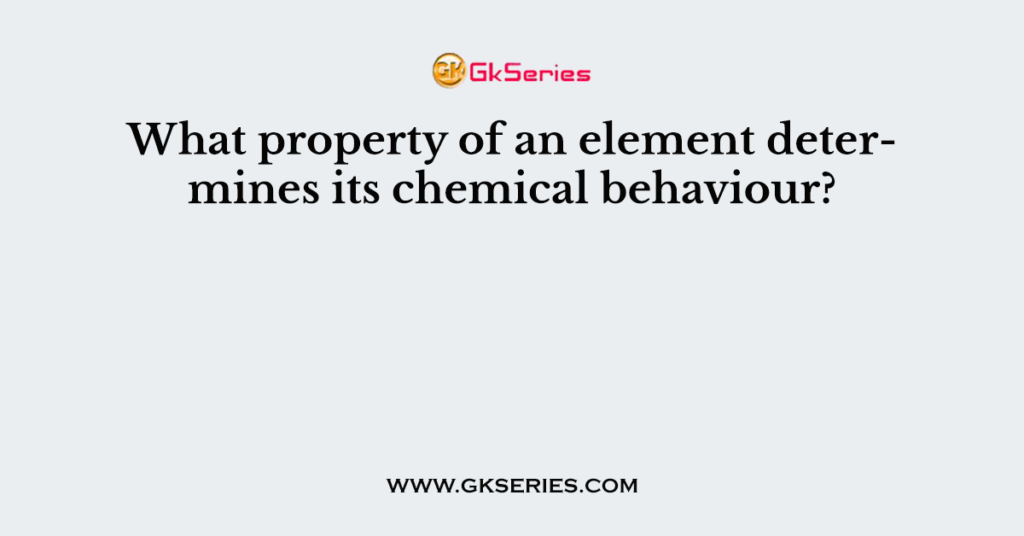The intriguing world of chemistry reveals itself through the lens of elemental behavior. Each element behaves like an enigmatic character in a grand narrative, influenced by a variety of underlying principles that govern its chemical properties. Understanding what determines these properties requires a detailed exploration of atomic structure, electron configuration, periodic trends, and intermolecular forces. This inquiry not only captures the imagination but also elucidates the complex relationships that underlie chemical reactivity.
At the heart of chemical behavior lies the atomic structure. An atom, the fundamental building block of matter, consists of a nucleus that houses protons and neutrons, surrounded by a cloud of electrons. The number of protons defines the atomic number and distinguishes one element from another, much like how a unique fingerprint identifies an individual. However, it is the arrangement and behavior of electrons in their respective energy levels or shells that ultimately dictate an element’s reactivity and chemical behavior.
Electrons reside in quantized energy levels, and the manner in which they configure themselves across these levels is dictated by the principles of quantum mechanics. The stability of an atom is akin to a tightly held secret; the closer electrons are to the nucleus, the more strongly they are bound and the less likely they are to participate in chemical reactions. Conversely, electrons located in the outermost shell, known as valence electrons, are central to chemical reactivity, since they are the ones involved in bond formation and breaking.
The concept of electron configuration serves as a powerful tool for predicting chemical properties. Elements are categorized according to their valence electrons—those residing in the outermost energy level. Sodium, for example, possesses a single valence electron, making it highly reactive, while neon, with a complete octet of valence electrons, exhibits remarkable stability and nonreactivity. This distinction encapsulates the intrinsic allure of elements; they are not mere symbols on the periodic table but dynamic entities trained to react in specific ways based on their electronic arrangement.
Periodic trends further enrich our understanding of chemical properties. The periodic table is more than a systematic arrangement of elements; it is a tapestry woven from established patterns that reveal how chemical properties change across periods and groups. For instance, as one traverses from left to right across a period, the electronegativity—the tendency of an atom to attract electrons—tends to increase. This phenomenon transforms the characters of the elements, providing insights into their chemical behavior and reactivity. Similarly, descending a group sees a decrease in ionization energy—the energy required to remove an electron—fostering the emergence of more reactive species.
Beyond atomic and periodic considerations, the nature of chemical bonds forged between atoms amplifies the complexity of chemical behavior. The primary types of chemical bonds include ionic, covalent, and metallic bonds, each with distinct characteristics. Ionic bonds, resulting from the transfer of electrons from one atom to another, tend to produce compounds with high melting points and electrical conductivity in liquid form. In stark contrast, covalent bonds—where electrons are shared—lead to the formation of compounds with variable properties, from volatile gases to robust solids.
The concept of electronegativity is instrumental in elucidating the nature of these bonds. An atom with high electronegativity, such as fluorine, exerts a strong pull on shared electrons, creating polar covalent bonds with less electronegative partners. This polarity conjures an array of chemical behaviors, from the solubility of substances to their intermolecular forces. The role of intermolecular forces,—such as hydrogen bonding, dipole-dipole interactions, and van der Waals forces—can significantly influence the physical properties of substances, showcasing how nuanced the determinants of chemical behavior can be.
Moreover, one cannot overlook the influence of environmental factors on chemical properties. Temperature, pressure, and concentration serve as variables that can dramatically alter the behavior of elements and compounds in a chemical reaction. An increase in temperature may provide the necessary energy to overcome activation barriers, ushering forth reactions that would otherwise remain dormant. Similarly, changes in pressure can affect the physical states of substances, thereby altering their reactivity.
In the grand narrative of chemistry, one must consider the contextual backdrop against which elements interact. Just as every character in a story brings their unique experience and perspective, each element’s environment conditions its potential for reaction. The combination of intrinsic properties—atomic structure, electron configuration, and bonding characteristics—coupled with extrinsic factors such as temperature and pressure weaves a rich tapestry that defines chemical behavior.
The question, “What determines the chemical properties of an element?” unfolds a narrative filled with remarkable intricacies. The underlying principles hinging on atomic structure, electron arrangement, periodic trends, bonding characteristics, and environmental influences coalesce, bestowing a unique persona upon each element. Knowledge of these factors not only fosters a deeper understanding of chemical reactions but also allows for the formulation of hypotheses regarding novel compounds and materials. Thus, the allure of chemistry lies not merely in its observable phenomena but in the intricate dance of atomic forces that govern all matter in our universe, inviting continued investigation and awe.












